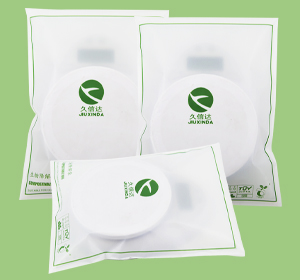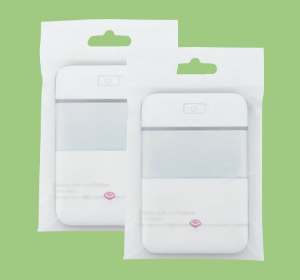Custom Biodegradable Packaging Bags
Customized biodegradable packaging bags, using PLA+PBAT materials, plant-based, compostable, environmentally friendly and zero pollution, can be customized in various bag types of biodegradable bags, widely used in the packaging industry, providing environmentally friendly packaging solutions.

Custom bag type
Our customized biodegradable packaging bags provide a variety of open bag solutions to help you enhance your product image and ensure the quality of your product packaging.
Self-adhesive bags
There is a sealing line at the bag opening. Align the lines on both sides of the bag opening.
Zipper Bag
Zipper bags can be divided into ordinary zipper bags, file zipper bags and invisible zipper bags.
Ziplock Bag
Ziplock bags are packaging bags that can be automatically sealed by pressing.
Flat Pocket
A flat bag is a plastic bag with a flat opening. Its advantage is that it has a larger opening area.
Rope Handle Bag
Drawstring bag, also called lock rope bag, drawstring bag, drawstring bag, is a kind of packaging bag.
Free Shape Packaging Bag
Customize biodegradable packaging bags in various shapes.
Customized biodegradable packaging bags according to industry
Our custom biodegradable bags are 100% compostable, biodegradable and can be customized as per the industry product packaging.

Clothing
Custom Clothing Packaging Bags

3C digital
Custom 3C digital product packaging bags

Glasses
Custom glasses packaging bags

Electrical appliances
Customi electrical packaging bags

Household Products
Custom Household Goods Packaging Bags

Express delivery
Custom courier packaging bags

Food
Custom Food Packaging Bags

Cosmetic
Custom cosmetic packaging bags
Custom success stories
What are biodegradable bags?
Under appropriate and time-limited natural environmental conditions, packaging bags that can be completely decomposed by microorganisms (such as bacteria, fungi and algae) into low molecular weight compounds. Degraded into water, carbon dioxide and minerals.
Types: ① Biodegradable natural polymer materials, such as cellulose, starch, etc.;
② Biodegradable plastics obtained by biosynthesis or chemical synthesis.
Material: PLA+PBAT.
Certificate: En13432 industrial composting, AS4736 (AU), BPI (US), OK Compost Home family composting
PLA: Polylactic acid, also known as polylactide, is a polyester polymer obtained by polymerization with lactic acid as the main raw material. It is a new type of biodegradable material.
PBAT: It is a thermoplastic biodegradable plastic material, a copolymer of butylene adipate and butylene terephthalate, and has the characteristics of both PBA and PBT. It has good ductility and elongation at break, as well as good heat resistance and impact resistance; in addition, it also has excellent biodegradability.
Advantages:
1. No pollution to the environment. The raw materials of PLA mainly come from sugars in renewable plant resources (such as corn, cassava, and sugarcane);
2. It can be degraded into water, carbon dioxide, and minerals. Polylactic acid (PLA) can be completely degraded by microorganisms in nature, will not cause a greenhouse effect, and will not cause any solid waste pollution;
3. Good degradability and compatibility;
4. It has good oxygen permeability and air permeability, and also has the characteristics of isolating odors.
FAQ
12 months under sealed conditions (prevent damage from moisture, soil, light, etc.). Those that are over 1 year old and within 1.5 years can still be used, but the edge sealing of the bag is not as good. The physical properties of degradable bags will slowly decrease with time, referring to the edge sealing, stretching, toughness and other physical properties. Bags will not be degraded if stored directly under normal conditions (avoid light and moisture). The premise of degradation must be the presence of microorganisms. Therefore, composting degradable bags requires a certain environment. But in fact, the back-end processing of degradable bags currently does not have a perfect processing system and has certain limitations. Therefore, some brands are excluded from degradable bags. Viscose fiber bags and paper bags do not have this restriction and meet the requirements of deplasticized packaging.
Degradation under composting conditions, home composting degradation time 12-18 months, industrial composting 3-6 months. Composting conditions: moisture (humidity) above 95%, soil, temperature (28-58 degrees), specific microorganisms.
Materials that can only be degraded into small fragments and cannot be converted into water and carbon dioxide within a specified time. Photo-oxidative degradation (D2W) adds 1-2% photo-oxidative additives to traditional PE materials. There are also PE and starch mixed materials, in which the starch part can be degraded, but the remaining PE part is still not degradable.
Infrared spectroscopy (comparing molecular structures) can be used to quickly identify the composition of plastic bags; chemical cracking methods can also be used (biodegradable materials can be quickly cracked under hot alkaline conditions, while ordinary plastic bags will not crack). The simplest and fastest method is combustion. Degradable bags burn with a neutral smell, while ordinary plastics burn with a pungent smell.

